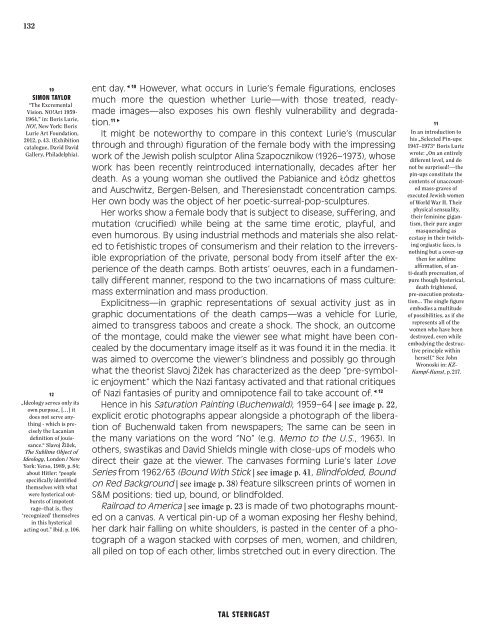The Art of
1WQggTh
1WQggTh
Create successful ePaper yourself
Turn your PDF publications into a flip-book with our unique Google optimized e-Paper software.
132<br />
10<br />
SIMON TAYLOR<br />
“<strong>The</strong> Excremental<br />
Vision. NO!<strong>Art</strong> 1959-<br />
1964,” in: Boris Lurie,<br />
NO!, New York: Boris<br />
Lurie <strong>Art</strong> Foundation,<br />
2012, p. 43. (Exhibition<br />
catalogue, David David<br />
Gallery, Philadelphia).<br />
12<br />
„Ideology serves only its<br />
own purpose, […] it<br />
does not serve anything<br />
- which is precisely<br />
the Lacanian<br />
definition <strong>of</strong> jouissance.“<br />
Slavoj Žižek,<br />
<strong>The</strong> Sublime Object <strong>of</strong><br />
Ideology, London / New<br />
York: Verso, 1989, p. 84;<br />
about Hitler: “people<br />
specifically identified<br />
themselves with what<br />
were hysterical outbursts<br />
<strong>of</strong> impotent<br />
rage–that is, they<br />
‘recognized’ themselves<br />
in this hysterical<br />
acting out.” Ibid. p. 106.<br />
ent day. 10 However, what occurs in Lurie’s female figurations, encloses<br />
much more the question whether Lurie—with those treated, readymade<br />
images—also exposes his own fleshly vulnerability and degradation.<br />
11<br />
It might be noteworthy to compare in this context Lurie’s (muscular<br />
through and through) figuration <strong>of</strong> the female body with the impressing<br />
work <strong>of</strong> the Jewish polish sculptor Alina Szapocznikow (1926–1973), whose<br />
work has been recently reintroduced internationally, decades after her<br />
death. As a young woman she outlived the Pabianice and Łódz ghettos<br />
and Auschwitz, Bergen-Belsen, and <strong>The</strong>resienstadt concentration camps.<br />
Her own body was the object <strong>of</strong> her poetic-surreal-pop-sculptures.<br />
Her works show a female body that is subject to disease, suffering, and<br />
mutation (crucified) while being at the same time erotic, playful, and<br />
even humorous. By using industrial methods and materials she also related<br />
to fetishistic tropes <strong>of</strong> consumerism and their relation to the irreversible<br />
expropriation <strong>of</strong> the private, personal body from itself after the experience<br />
<strong>of</strong> the death camps. Both artists’ oeuvres, each in a fundamentally<br />
different manner, respond to the two incarnations <strong>of</strong> mass culture:<br />
mass extermination and mass production.<br />
Explicitness—in graphic representations <strong>of</strong> sexual activity just as in<br />
graphic documentations <strong>of</strong> the death camps—was a vehicle for Lurie,<br />
aimed to transgress taboos and create a shock. <strong>The</strong> shock, an outcome<br />
<strong>of</strong> the montage, could make the viewer see what might have been concealed<br />
by the documentary image itself as it was found it in the media. It<br />
was aimed to overcome the viewer’s blindness and possibly go through<br />
what the theorist Slavoj Žižek has characterized as the deep “pre-symbolic<br />
enjoyment” which the Nazi fantasy activated and that rational critiques<br />
<strong>of</strong> Nazi fantasies <strong>of</strong> purity and omnipotence fail to take account <strong>of</strong>. 12<br />
Hence in his Saturation Painting (Buchenwald), 1959–64 | see image p. 22,<br />
explicit erotic photographs appear alongside a photograph <strong>of</strong> the liberation<br />
<strong>of</strong> Buchenwald taken from newspapers; <strong>The</strong> same can be seen in<br />
the many variations on the word “No” (e.g. Memo to the U.S., 1963). In<br />
others, swastikas and David Shields mingle with close-ups <strong>of</strong> models who<br />
direct their gaze at the viewer. <strong>The</strong> canvases forming Lurie’s later Love<br />
Series from 1962/63 (Bound With Stick | see image p. 41, Blindfolded, Bound<br />
on Red Background | see image p. 38) feature silkscreen prints <strong>of</strong> women in<br />
S&M positions: tied up, bound, or blindfolded.<br />
Railroad to America | see image p. 23 is made <strong>of</strong> two photographs mounted<br />
on a canvas. A vertical pin-up <strong>of</strong> a woman exposing her fleshy behind,<br />
her dark hair falling on white shoulders, is pasted in the center <strong>of</strong> a photograph<br />
<strong>of</strong> a wagon stacked with corpses <strong>of</strong> men, women, and children,<br />
all piled on top <strong>of</strong> each other, limbs stretched out in every direction. <strong>The</strong><br />
11<br />
In an introduction to<br />
his „Selected Pin-ups:<br />
1947–1973“ Boris Lurie<br />
wrote: „On an entirely<br />
different level, and do<br />
not be surprised!—the<br />
pin-ups constitute the<br />
contents <strong>of</strong> unaccounted<br />
mass-graves <strong>of</strong><br />
executed Jewish women<br />
<strong>of</strong> World War II. <strong>The</strong>ir<br />
physical sensuality,<br />
their feminine gigantism,<br />
their pure anger<br />
masquerading as<br />
ecstasy in their twitching<br />
orgiastic faces, is<br />
nothing but a cover-up<br />
then for sublime<br />
affirmation, <strong>of</strong> anti-death<br />
procreation, <strong>of</strong><br />
pure though hysterical,<br />
death frightened,<br />
pre-execution protestation...<br />
<strong>The</strong> single figure<br />
embodies a multitude<br />
<strong>of</strong> possibilities, as if she<br />
represents all <strong>of</strong> the<br />
women who have been<br />
destroyed, even while<br />
embodying the destructive<br />
principle within<br />
herself.“ See John<br />
Wronoski in: KZ-<br />
Kampf-Kunst, p. 217.<br />
TAL STERNGAST


